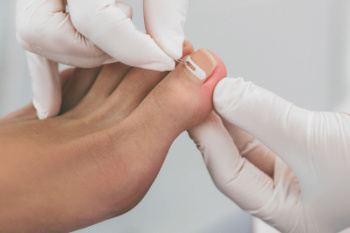Connect With Us
Blog
Items filtered by date: August 2024
What to Look for in a Walking Shoe

When selecting walking shoes, comfort and support are key factors that contribute to foot health. It is important to choose shoes that fit well from the start, as poorly fitting shoes can lead to issues such as plantar fasciitis or Achilles tendinitis. Look for walking shoes with a flexible sole that allows for natural foot movement, and avoid those with overly thick heels that can disrupt your stride. Shopping for shoes later in the day, when your feet are slightly swollen, can help ensure a better fit. Additionally, wearing the socks you plan to walk in while trying on shoes can make a difference in comfort. Remember to leave some space for your toes to move, as tight shoes can lead to blisters and other problems. If you experience foot pain after walking, it is suggested that you schedule an appointment with a podiatrist to see if your footwear is part of the problem.
It is important to find shoes that fit you properly in order to avoid a variety of different foot problems. For more information about treatment, contact Dr. Nicholas Przystawski from Central Florida Foot Care, PA. Our doctor will treat your foot and ankle needs.
Proper Shoe Fitting
Shoes have many different functions. They cushion our body weight, protect our feet, and allow us to safely play sports. You should always make sure that the shoes you wear fit you properly in order to avoid injuries and deformities such as: bunions, corns, calluses, hammertoes, plantar fasciitis, stress fractures, and more. It is important to note that although a certain pair of shoes might be a great fit for someone else, that doesn’t mean they will be a great fit for you. This is why you should always try on shoes before buying them to make sure they are worth the investment. Typically, shoes need to be replaced ever six months to one year of regular use.
Tips for Proper Shoe Fitting
- Select a shoe that is shaped like your foot
- Don’t buy shoes that fit too tight, expecting them to stretch to fit
- Make sure there is enough space (3/8” to ½”) for your longest toe at the end of each shoe when you are standing up
- Walk in the shoes to make sure they fit and feel right
- Don’t select shoes by the size marked inside the shoe, but by how the shoe fits your foot
The shoes you buy should always feel as good as they look. Shoes that fit properly will last longer, feel better, and improve your way of life each day.
If you have any questions, please feel free to contact our office located in Leesburg, FL . We offer the newest diagnostic and treatment technologies for all your foot care needs.
How to Deal With an Ingrown Toenail

Ingrown toenails occur when the edge of the toenail grows into the surrounding skin, causing pain, swelling, and sometimes infection. Common causes include improper nail trimming, where nails are cut too short or rounded, leading to the nail growing into the skin. Tight or ill-fitting shoes can also press the toenail into the skin, making the problem worse. Genetic factors and trauma to the toenail, such as stubbing or injury, may contribute to the condition as well. Preventing ingrown toenails involves several strategies. First, trim toenails straight across without rounding the edges, and avoid cutting them too short. Wearing well-fitting shoes with enough toe room can reduce pressure on the toenails. Maintaining good foot hygiene helps prevent infections if an ingrown toenail does occur. If symptoms persist or an infection develops, it's suggested you contact a podiatrist for appropriate treatment and to avoid complications.
Ingrown toenails can become painful if they are not treated properly. For more information about ingrown toenails, contact Dr. Nicholas Przystawski of Central Florida Foot Care, PA. Our doctor can provide the care you need to keep you pain-free and on your feet.
Ingrown Toenails
Ingrown toenails occur when a toenail grows sideways into the bed of the nail, causing pain, swelling, and possibly infection.
Causes
- Bacterial infections
- Improper nail cutting such as cutting it too short or not straight across
- Trauma to the toe, such as stubbing, which causes the nail to grow back irregularly
- Ill-fitting shoes that bunch the toes too close together
- Genetic predisposition
Prevention
Because ingrown toenails are not something found outside of shoe-wearing cultures, going barefoot as often as possible will decrease the likeliness of developing ingrown toenails. Wearing proper fitting shoes and using proper cutting techniques will also help decrease your risk of developing ingrown toenails.
Treatment
Ingrown toenails are a very treatable foot condition. In minor cases, soaking the affected area in salt or antibacterial soaps will not only help with the ingrown nail itself, but also help prevent any infections from occurring. In more severe cases, surgery is an option. In either case, speaking to your podiatrist about this condition will help you get a better understanding of specific treatment options that are right for you.
If you have any questions please feel free to contact our office located in Leesburg, FL . We offer the newest diagnostic and treatment technologies for all your foot and ankle needs.
Common Foot Injuries From Running

Running frequently leads to foot injuries, including skin and toenail damage, plantar fasciitis, metatarsalgia, and peroneal tendonitis. Skin conditions like blisters and calluses often arise from friction and improper footwear. Toenail damage, including bruised or ingrown nails, can occur from repetitive impact and tight shoes. Plantar fasciitis, characterized by heel pain and inflammation of the foot's connective tissue, is common among runners. Metatarsalgia causes pain in the ball of the foot due to overuse or poor arch support. Peroneal tendonitis results in pain along the outer side of the ankle from excessive strain. To manage these conditions, rest and appropriate treatment are essential. Wearing well-fitted, supportive shoes, using orthotic inserts, and incorporating stretching and strengthening exercises can help prevent and relieve these common running-related injuries. If you have endured a foot or ankle injury while running, it is suggested that you visit a podiatrist who can effectively treat your foot condition.
Sports related foot and ankle injuries require proper treatment before players can go back to their regular routines. For more information, contact Dr. Nicholas Przystawski of Central Florida Foot Care, PA. Our doctor can provide the care you need to keep you pain-free and on your feet.
Sports Related Foot and Ankle Injuries
Foot and ankle injuries are a common occurrence when it comes to athletes of any sport. While many athletes dismiss the initial aches and pains, the truth is that ignoring potential foot and ankle injuries can lead to serious problems. As athletes continue to place pressure and strain the area further, a mild injury can turn into something as serious as a rupture and may lead to a permanent disability. There are many factors that contribute to sports related foot and ankle injuries, which include failure to warm up properly, not providing support or wearing bad footwear. Common injuries and conditions athletes face, including:
- Plantar Fasciitis
- Plantar Fasciosis
- Achilles Tendinitis
- Achilles Tendon Rupture
- Ankle Sprains
Sports related injuries are commonly treated using the RICE method. This includes rest, applying ice to the injured area, compression and elevating the ankle. More serious sprains and injuries may require surgery, which could include arthroscopic and reconstructive surgery. Rehabilitation and therapy may also be required in order to get any recovering athlete to become fully functional again. Any unusual aches and pains an athlete sustains must be evaluated by a licensed, reputable medical professional.
If you have any questions please feel free to contact our office located in Leesburg, FL . We offer the newest diagnostic and treatment technologies for all your foot and ankle needs.
Reminder: When Was the Last Time...?
Facts on Flat Feet Surgery

Flat feet surgery aims to correct the arch of the foot and alleviate associated symptoms like pain and difficulty walking. There are various types of surgical procedures, depending on the severity and underlying cause of the flat feet condition. Lateral column lengthening involves cutting and repositioning bones in the outer foot to create an arch. This procedure stabilizes the midfoot and improves weight distribution. Flexor digitorum longus transfer redirects a tendon from the toe to support the arch, enhancing its structure and function. Both surgeries aim to restore the foot's natural alignment and reduce strain on surrounding muscles and joints. Recovery typically involves immobilization to regain strength and mobility. Surgical intervention is considered when conservative treatments like orthotics and exercises fail to provide sufficient relief, aiming to improve foot function and quality of life for individuals with flat feet. If you are experiencing chronic pain from having flat feet, it is strongly suggested that you consult a podiatrist who can determine if flat foot surgery is right for you.
Foot surgery is sometimes necessary to treat a foot ailment. To learn more, contact Dr. Nicholas Przystawski of Central Florida Foot Care, PA. Our doctor will assist you with all of your foot and ankle needs.
When Is Surgery Necessary?
Foot and ankle surgery is generally reserved for cases in which less invasive, conservative procedures have failed to alleviate the problem. Some of the cases in which surgery may be necessary include:
- Removing foot deformities like bunions and bone spurs
- Severe arthritis that has caused bone issues
- Cosmetic reconstruction
What Types of Surgery Are There?
The type of surgery you receive will depend on the nature of the problem you have. Some of the possible surgeries include:
- Bunionectomy for painful bunions
- Surgical fusion for realignment of bones
- Neuropathy decompression surgery to treat nerve damage
Benefits of Surgery
Although surgery is usually a last resort, it can provide more complete pain relief compared to non-surgical methods and may allow you to finally resume full activity.
Surgical techniques have also become increasingly sophisticated. Techniques like endoscopic surgery allow for smaller incisions and faster recovery times.
If you have any questions please feel free to contact our office located in Leesburg, FL . We offer the newest diagnostic and treatment technologies for all your foot and ankle needs.

